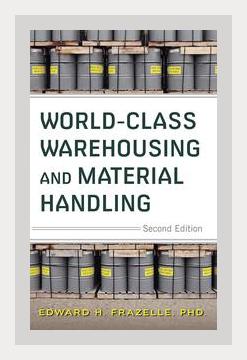Operations and Supply Chain ManagementInventory Management
**
Introduction
“World-Class Warehousing and Material Handling” by Edward H. Frazelle, published in 2002, provides an in-depth exploration into efficient and effective warehousing and material handling practices. Aimed at professionals in inventory management, the book is a comprehensive guide to understanding the principles of world-class warehouse management and achieving excellence.
Chapter 1: Importance of World-Class Warehousing
Frazelle begins by highlighting the importance of warehousing in the broader context of supply chain management. He emphasizes that warehousing is not just about storing goods but also about integrating logistics and optimizing flow.
Action Step: A person can start by assessing the strategic role their warehouse plays in the overall supply chain and identifying opportunities to improve integration with other logistical functions.
Example: Frazelle cites the case of a retail company that reduced lead times and improved customer satisfaction by optimizing its warehousing processes.
Chapter 2: Design Criteria for World-Class Warehousing
In this chapter, Frazelle introduces the key design criteria that define world-class warehousing: space utilization, equipment, layout, production support, personnel needs, and cost.
Action Step: Evaluate current warehouse designs against these criteria and make adjustments to optimize space and flow.
Example: The book discusses how a pharmaceutical company redesigned its warehouse layout to improve space utilization, resulting in a 25% increase in storage capacity without additional external storage.
Chapter 3: Warehouse Operations Management
Frazelle provides a detailed analysis of operations management, emphasizing the importance of efficiency and productivity. He discusses receiving, put-away, storage, picking, packing, and shipping as critical components.
Action Step: Implement standard operating procedures (SOPs) for each operation to ensure consistency and efficiency.
Example: A case study describes a company that reduced picking errors and improved order accuracy by 15% after introducing SOPs for its picking process.
Chapter 4: Inventory Management
Inventory management is crucial for maintaining optimal stock levels and minimizing costs. Frazelle discusses various inventory strategies, including Just-in-Time (JIT), Economic Order Quantity (EOQ), and ABC analysis.
Action Step: Conduct an ABC analysis to prioritize inventory based on value and turnover rates.
Example: The book illustrates how an electronics manufacturer categorized its inventory using ABC analysis, leading to more focused management of high-value items and reducing overall inventory costs by 10%.
Chapter 5: Material Handling Systems
Frazelle introduces different material handling systems, such as conveyors, automated guided vehicles (AGVs), and robotics. He stresses the importance of choosing the right system based on warehouse needs and operational goals.
Action Step: Conduct a thorough analysis of current material handling processes to identify opportunities for automation or mechanization.
Example: A distribution center implemented AGVs, reducing manual labor and improving throughput by 20%.
Chapter 6: Information Systems and Technology
The role of IT in warehousing is paramount in modern logistics. Frazelle discusses Warehouse Management Systems (WMS), barcoding, RFID, and other technological advancements that can enhance efficiency and accuracy.
Action Step: Invest in a robust WMS to streamline operations and improve data accuracy.
Example: A case study describes a company that implemented a WMS and saw a 30% improvement in inventory accuracy, along with significant labor cost reductions.
Chapter 7: Human Resource Management
Effective human resource management is critical in achieving world-class warehousing. Frazelle emphasizes training, ergonomics, labor standards, and safety.
Action Step: Develop a comprehensive training program for warehouse staff to ensure they are well-versed in best practices and safety protocols.
Example: An automotive parts supplier reduced workplace injuries by 40% after implementing ergonomic training and redesigning workstations to reduce strain.
Chapter 8: Performance Measurement and Benchmarking
Frazelle advocates for continuous improvement through performance measurement and benchmarking. Key performance indicators (KPIs) such as order accuracy, cycle time, and cost per order are essential for measuring success.
Action Step: Establish KPIs appropriate for your warehouse and use them to identify areas for improvement.
Example: A food and beverage company used benchmarking to compare its order accuracy against industry standards and implemented changes that improved accuracy by 12%.
Chapter 9: Continuous Improvement and Lean Warehousing
The final chapter addresses the importance of continuous improvement and adopting lean warehousing principles to minimize waste and maximize value.
Action Step: Implement lean warehousing techniques such as 5S (Sort, Set in Order, Shine, Standardize, Sustain) to maintain an organized and efficient workspace.
Example: The book details how a furniture manufacturer used lean principles to streamline its warehousing operations, cutting lead times by 50% and reducing costs by 20%.
Conclusion
Edward H. Frazelle’s “World-Class Warehousing and Material Handling” serves as an essential resource for improving warehousing operations. Through strategic design, efficient operations management, advanced material handling systems, robust IT, comprehensive human resource strategies, and a continuous improvement mindset, businesses can achieve world-class standards in warehousing.
Key Takeaways:
-
Strategic Role Assessment: Understand the warehouse’s role in the supply chain.
- Example: Retailer optimizing warehouse for faster customer delivery.
-
Design Criteria: Optimize space, layout, and equipment.
- Example: Pharmaceutical company increasing storage without extra space.
-
Operations Management: Standardize procedures for efficiency.
- Example: Reducing errors by implementing picking SOPs.
-
Inventory Management: Use strategies like ABC analysis.
- Example: Electronics manufacturer saving costs with focused inventory management.
-
Material Handling: Evaluate and implement appropriate systems.
- Example: Distribution center increasing throughput with AGVs.
-
Information Systems: Invest in WMS and related technologies.
- Example: Inventory accuracy improvement with WMS.
-
Human Resources: Train staff and prioritize ergonomics.
- Example: Decreased injuries with ergonomic training.
-
Performance Measurement: Use KPIs and benchmarking.
- Example: Food company improving order accuracy.
-
Lean Warehousing: Apply lean principles for continuous improvement.
- Example: Furniture manufacturer reducing lead times and costs.
